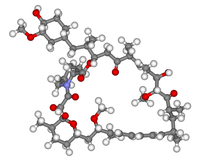
Photo from wikipedia
Sphingomyelin (SM) is required for cells to proliferate, but the reason is not fully understood. In order to asses this question, we employed a cell line, ZS, which lacks both… Click to show full abstract
Sphingomyelin (SM) is required for cells to proliferate, but the reason is not fully understood. In order to asses this question, we employed a cell line, ZS, which lacks both SMS1 and SMS2, isolated from mouse embryonic fibroblasts in SMS1 and 2 double knockout mouse, and SMS1 or SMS2 re‐expressing cells, ZS/SMS1 or ZS/SMS2, respectively. We investigated regulation of SM in activating the mammalian target of rapamycin (mTOR) signal induced by essential amino acids (EAA), using these cells. EAA‐stimulated mTOR signal was more activated in ZS/SMS1 and ZS/SMS2 cells than in controls. Treatment with methyl‐b‐cyclodextrin dramatically inhibited the activation. Interestingly, we found that the expression of CD98, LAT‐1 and ASCT‐2, amino acid transporters concerned with mTOR activation, was down‐regulated in ZS cells. Transporters localized in microdomains and formed a functional complex. Our results indicate that SM affect proliferation through the transport of amino acids via SM‐enriched microdomains.
Journal Title: Cell Biology International
Year Published: 2018
Link to full text (if available)
Share on Social Media: Sign Up to like & get
recommendations!